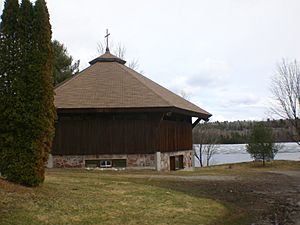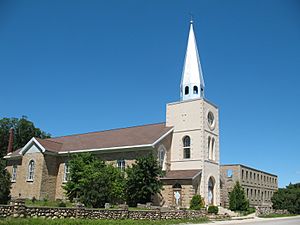Anishinabe Spiritual Centre facts for kids
Quick facts for kids Anishinabe Spiritual Centre |
|
|---|---|
|
Ojibwe: Wassean-dimi-Kaning
|
|

View of chapel and Anderson Lake
|
|
| Lua error in Module:Location_map at line 420: attempt to index field 'wikibase' (a nil value). | |
| Location | Espanola, Ontario |
| Country | Canada |
| Denomination | Roman Catholic |
| Website | AnishinabeSpiritualCentre.ca |
| History | |
| Status | Active |
| Founded | 1972 |
| Founder(s) | Society of Jesus |
| Architecture | |
| Functional status | Training and Spirituality centre |
| Groundbreaking | 1982 |
| Completed | June 1985 |
| Administration | |
| Parish | St. Jude, Espanola |
| Diocese | Sault Sainte Marie |
| Province | Kingston |
The Anishinabe Spiritual Centre (called Ojibwe: Wassean-dimi-Kaning in Ojibwe) is a special Roman Catholic place. It helps people learn about their faith and train for church roles. The Society of Jesus (Jesuits) runs this centre in Espanola, Ontario, Canada. It is made especially for the local First Nation people.
The centre is located south of Espanola, right on the shore of Anderson Lake. It is just off Ontario Highway 6. Since it started, it has been the only place in northern Ontario to offer Roman Catholic training to Indigenous people.
History of the Centre
How it Started
After a big meeting called the Second Vatican Council, there was a push in Canada to have more permanent deacons. Deacons are church helpers who can perform some religious services. From 1972 to 1979, the Jesuits ran a training program for deacons in northern Ontario. The Bishop of Sault Sainte Marie, Alexander Carter, supported this program.
However, the program only lasted seven years. The people traveling around to offer training became very tired. So, everyone decided that a permanent place was needed for the training program.
Building the Centre
Money was collected to build the new centre. Funds came from the Jesuits and from several Roman Catholic dioceses. These included Sault Sainte Marie, Hearst, and Thunder Bay.
Volunteers built the centre, and they even set up a sawmill on site to help with the construction. Building started in 1982. By 1984, the main building and the chapel were finished. In 1985, the other smaller buildings were completed. Bishop Carter officially opened the centre in June 1985.
What the Centre Does
The main goal of the centre was to train men to become deacons. But it also trained women for a group called the Diocesan Order of Women. Later, this group changed to the Diocesan Order of Service, which both men and women could join. The centre also holds monthly "Ministries weekends" for Roman Catholics from all over northern Ontario.
In the 1990s, some First Nation people from the centre helped bring an old path back to life. This path is called the Heaven's Gate trail. It was an old trade route used by their ancestors. The trail is 40 kilometers long and goes across the La Cloche Mountain range.
Churches Served by the Centre
Jesuits from the Anishinabe Spiritual Centre also travel to serve different churches in the area. Here are some of them:
Holy Cross Church, Wiikwemkoong
Besides running the spiritual centre, the Jesuits also help the Anishinaabe people at Holy Cross Church. This church is located in the Wiikwemkoong Unceded Reserve.
St. Raphael Church, Sagamok
St. Raphael Church serves the Sagamok Anishnawbek First Nation. This is a large reserve located west of Sudbury, Ontario. The reserve is one of the biggest in the region, with about 2,200 people. It covers a large area of 27,000 acres. The church building is made of white brick. Inside, the walls are made of white pine wood. Above the altar, there is a painting of Jesus Christ appearing in a vision to a First Nation person.
Our Lady of the Highway Church, Cutler
The priest from St. Raphael Church also helps out at Our Lady of the Highway Church. This church serves the Serpent River First Nation in Cutler, Ontario. In 2001, the Serpent River community in Cutler had 289 people living in 142 homes. It is located by Lake Huron, about 40 kilometers east of Blind River, Ontario.
Immaculate Conception Church, Manitoulin
The Church of the Immaculate Conception is located within the M'Chigeeng First Nation in Manitoulin District. It is right across the street from the Ojibwe Cultural Museum. The first church building was started in 1854. However, its roots go back to Jesuit missions on the island between 1648 and 1650.
In 1971, the original church building was destroyed in an explosion. A new building was built in 1972. Its design was influenced by the Second Vatican Council's ideas about church services. It is a round building with a cone-shaped roof, like a teepee. Inside the church, the "Stations of the Cross" (pictures showing Jesus's journey) were painted by an artist named Leland Bell.
Immaculate Heart of Mary Church, Gore Bay
From the Immaculate Conception Church, the priest also travels to Immaculate Heart of Mary Church. This church serves the Catholic people living in Gore Bay, Ontario. Gore Bay is one of the two main towns in the Manitoulin District.
St. Joseph Church, Sheshegwaning
The priest from Immaculate Conception Church also visits St. Joseph's Church in Sheshegwaning. This church is on the east coast of Manitoulin Island. It is located near the Kenjgewin Teg Educational Institute.
Gallery
See also
- List of Jesuit sites
- St. Andrew's Church, Thunder Bay





